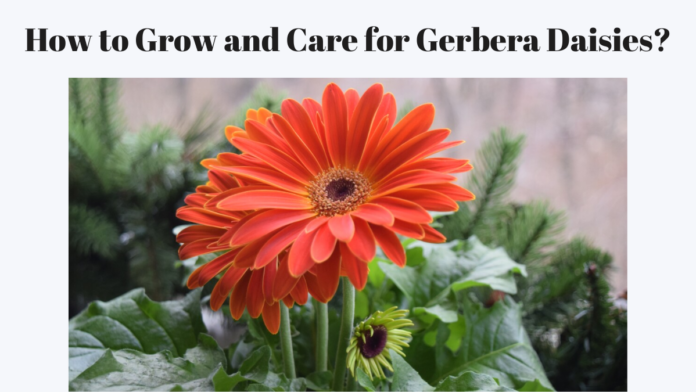Gerbera daisy is among the most popular and cheerful flower that can brighten any garden or indoor space. With their vibrant colours and bold silhouettes, it is no wonder why they are a favourite among flower enthusiasts.
But growing and caring for gerbera daisy requires some attention to detail, and with this article, you will learn everything you need to know to grow these happy flowers.
Choosing the Right Variety
Before you start growing gerbera daisy, it is essential to choose the right variety for your climate and desired level of maintenance. Gerbera daisies come in various colours, including pink, orange, yellow, white, and red, and some varieties have bi-coloured or tri-coloured petals. Some popular varieties include ‘Terracotta’, ‘Winter Queen’, and ‘Giant Spinner’.
When selecting a variety, consider the level of sunlight your garden receives, as some gerbera daisies require more sunlight than others. You can also choose varieties specifically bred for indoor growing or for specific climates.
Planting Gerbera Daisies
Gerbera daisies are typically grown from seed or from nursery-grown plants. If you are starting from seed, sow them indoors 8-10 weeks before the last frost date in your area. Keep the soil warm and moist, and provide indirect light.
Transplant the seedlings outdoors when they have 2-3 sets of leaves, spacing them 12-18 inches apart.
If you are using nursery-grown plants, plant them in the spring or fall when the weather is mild. Dig a hole that’s twice as wide and as deep as the pot, and add a layer of compost or well-rotted manure.
Gently remove the plant from its pot and place it in the hole, ensuring the crown (where the stem meets the roots) is level with the soil surface. Fill the hole with soil and water well.
Soil and Watering
Gerbera daisy prefer well-draining soil that’s rich in organic matter. Suppose your soil is heavy clay or sandy; mix in some compost or perlite to improve drainage. Water your gerbera daisies regularly, but make sure the soil is not waterlogged.
Check the soil moisture by inserting your finger into the soil up to the first knuckle. If the soil feels dry, it is time to water. Water at the base of the plant to avoid getting water on the leaves, which can cause fungal diseases.
Sunlight and Temperature
Gerbera daisies require full sun to partial shade, depending on the variety. If you are growing them indoors, place them in a south-facing window or under grow lights.
The ideal temperature for gerbera daisies is between 65°F and 75°F (18°C and 24°C), with a minimum of 55°F (13°C) at night.
Avoid placing them near heating vents or air conditioning units, as this can cause temperature fluctuations.
Fertilizing
Feed your gerbera daisy with a balanced fertilizer (10-10-10 NPK) once a month. You can also use a bloom-boosting fertilizer (higher phosphorus content) to promote more flowers.
Dilute the fertilizer to half the recommended strength to avoid burning the roots. For indoor plants, use a liquid fertilizer specifically designed for houseplants, following the instructions on the label.
Pruning and Deadheading
Pruning and deadheading are essential for encouraging gerbera daisies to bloom more profusely. Remove any dead or damaged leaves or stems to prevent the spread of disease.
After the flowers have bloomed, cut off the stem just above a leaf node (where a leaf meets the stem) to encourage a new bloom, you can also trim off any leggy stems to maintain a bushy shape.
Pest and Disease Control
Gerbera daisies are susceptible to pests like aphids, whiteflies, and spider mites. Check your plants regularly for signs of infestation, such as curled or distorted leaves or sticky honeydew droplets.
Use neem oil or insecticidal soap to control infestations. Fungal diseases like crown rot and leaf spot can also affect gerbera daisies. Remove any infected leaves or stems, and treat the plant with a fungicide if necessary.
Propagation
Gerbera daisys can be propagated through division, cuttings, or seed. Division is the most common method, as it is easier and faster. Dig up the entire plant, gently separating the roots, and replant the divisions in the spring or fall.
Cuttings can be taken from the tips of the stems, and seedlings can be started indoors 8-10 weeks before the last frost date.
Tips and Tricks
- Gerbera daisies are sensitive to frost, so protect them with a layer of mulch or bring them indoors if you live in an area with harsh winters.
- Avoid overwatering, as this can lead to root rot and other problems.
- Gerbera daisies can be grown in containers, but make sure the pot is at least 6-8 inches deep to accommodate the roots.
- Consider growing gerbera daisies in a greenhouse or indoor space if you live in an area with extreme temperatures or humidity.
Conclusion
In conclusion, growing and caring for gerbera daisy requires attention to detail, but the rewards are worth the effort. These flowers can brighten up any garden or indoor space with their vibrant colours and cheerful blooms.
Some Questions
What is a Gerbera Daisy?
Gerbera Daisies are a type of flowering plant known for their bright, daisy-like flowers that come in a range of colors and sizes.
How do I care for Gerbera Daisies indoors?
Gerbera Daisies require bright light, moderate temperatures (40-70°F/4-21°C), and moderate watering. They also need fertilization and pest control to stay healthy.
Can I grow Gerbera Daisies outdoors?
Yes, Gerbera Daisies can be grown outdoors in well-draining soil and full sun to partial shade. They require regular watering and fertilization to thrive.
What are some common pests that affect Gerbera Daisies?
Gerbera Daisies are susceptible to pests like aphids, whiteflies, spider mites, and thrips. Regular monitoring and treatment with horticultural oil or insecticidal soap can help control infestations.














